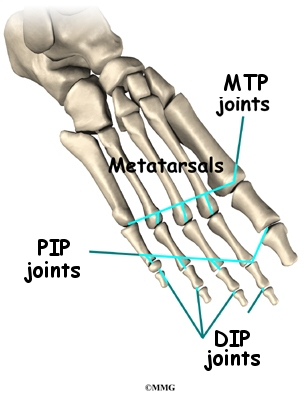
The PIP joint is the first joint of the finger and is located between the first two bones of the finger. Proximal Interphalangeal Joint (PIP Joint) Common problems at this joint include Mallet Finger, Jersey Finger, arthritis, mucous cysts, and fractures. The DIP joint in the finger is located at the tip of the finger, just before the finger nail starts. Middle Finger Distal Interphalangeal Joint (DIP Joint) Occasionally, joint pain can be caused by a CMC boss. Injuries and problems with this joint are uncommon. The index CMC joint has little motion this provides a more rigid and stable radial column to the hand. Common problems at the MCP joint include arthritis and collateral ligament injuries. You can spread your fingers more more easily when they are straightened rather than bent because the collateral ligaments are loose when the finger is extended. The MP joints allows you to bend and flex your fingers, spread your fingers, and bring the fingers together. MP joints are important for both power grip and pinch activities they are where the fingers move with respect to the hand. The MP joint is where the hand bone called the metacarpal meets the finger bones called the phalanges. Common injuries include sprains, fractures, dislocations, arthritis, and extensor tendon ruptures (leads to Boutonnière deformity), and hyperextension (Swan neck). The PIP joint can bend and extend the finger. The index finger is more likely to develop arthritis from the pinch force that occurs throughout one’s life. Common injuries to this joint include a Bennett’s fracture and a Rolando’s fracture.

Surgical treatment for arthritis of the joint often includes removal of the trapezium or resurfacing of the joint. The thumb CMC joint is one of the most common areas in the hand and wrist to develop arthritis. The adductor pollicis helps move the thumb toward the hand. The abductor pollicis longus and brevis help move the thumb away from the hand. Two very important ligaments are the dorsoradial and the volar beak ligaments. The thumb metacarpal can bend and extend the thumb, move the thumb away from and toward the hand, and spin the thumb on the trapezium. The thumb CMC joint has the most freedom of motion.

The ulnar collateral ligament of the thumb MP joint is important to stabilize the thumb during most pinch activities and is commonly injured. The MP joint primarily allows you to bend and extend the thumb. MP joints are important for both power grip and pinch activities they are where the fingers move in relation to the hand. A single finger bone is called a phalanx. The MP joint is where the hand bone, called the metacarpal, meets the finger bones, called the phalanges. The radial and ulnar collateral ligaments are important to provide stability of the fingertip during pinching. The terminal extensor tendon in the thumb comes from the extensor pollicis longus muscle. The IP joint in thumb is located at the tip of the finger just before the fingernail starts. The thumb interphalangeal (IP) joint is similar to the distal interphalangeal (DIP) joint in the fingers. The thumb digit has only two phalanges (bones) so it only has one joint. When discussing hand joints, we refer to the palmar or volar surface (the palm side), the dorsal surface (the back of the hand), the radial side (toward the thumb), and the ulnar side (toward the little finger). The tough fibrous tissue is often what is injured when you have a sprain of a joint. The synovium has multiple functions including to help provide fluid for lubrication of the joint.

Our joints typically have a capsule of tough, but flexible, fibrous tissue that helps hold the joints together and an inner lining of synovium. When cartilage is healthy, there is a cushioning effect of the cartilage that absorbs and evens out the forces across the joint. Cartilage is a smooth surface that allows for gliding. The joints in our hands are made up of cartilage surfaces that cap the bones.


 0 kommentar(er)
0 kommentar(er)
